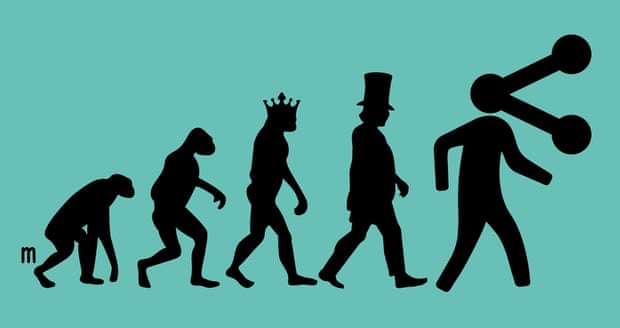Wednesday, March 28, 2018
Have 99.999% Missed The Real Revolutionary Possibilities of Crypto?
By
CNu
at
March 28, 2018
0
comments
![]()
Labels: banksterism , Breakaway Civilization , computationalism , count zero , culture of competence , disintermediation , gain of function , not gonna happen... , TIA
Sunday, March 18, 2018
Scientific Integrity Within the Academic and Media Industrial Complexes
By
CNu
at
March 18, 2018
0
comments
![]()
Labels: disintermediation , FAIL , fraud , hypnosis , information anarchy , Livestock Management , propaganda , reality casualties , What IT DO Shawty...
Tuesday, March 06, 2018
The Internet "Defeated Censorship"? What A Quaint Notion...,
By
CNu
at
March 06, 2018
0
comments
![]()
Labels: corporatism , disinformation , disintermediation , Dystopian Now , information anarchy
Thursday, December 28, 2017
Why Trust Anything Privileged, Cozy And Personally Dependent On The Status Quo?
Sunday, December 10, 2017
Next Up: Ekmanized Pre-Cog Face-Reading AI...,
By
CNu
at
December 10, 2017
0
comments
![]()
Labels: AI , cognitive infiltration , disintermediation , Livestock Management , subliminal , tricknology
Friday, December 08, 2017
Still Not A Peep From The MSM On Trump Israel Collusion...,
By
CNu
at
December 08, 2017
0
comments
![]()
Labels: .45 , 2parties1ideology , American Original , corporatism , disinformation , disintermediation , governance , Livestock Management , presstitution , propaganda , What IT DO Shawty...
Tuesday, December 05, 2017
From ‘Russia-Gate’ to ‘Israel-Gate’
By
CNu
at
December 05, 2017
0
comments
![]()
Labels: 2parties1ideology , American Original , corporatism , disinformation , disintermediation , governance , Livestock Management , presstitution , propaganda , What IT DO Shawty...
Russiagate The Excuse For Stifling U.S. Dissent
By
CNu
at
December 05, 2017
0
comments
![]()
Labels: 2parties1ideology , American Original , corporatism , disinformation , disintermediation , governance , Livestock Management , presstitution , propaganda , What IT DO Shawty...
Sunday, December 03, 2017
Is Dis-Inter-Mediation Necessarily A Bad Thing?
By
CNu
at
December 03, 2017
0
comments
![]()
Labels: cognitive infiltration , disintermediation , hegemony , narrative , political economy , What Now?
Friday, September 15, 2017
Vikram Pandit Says 1.8 Million Bank Employees Gotta Go Gotta Go Gotta Go...,
By
CNu
at
September 15, 2017
0
comments
![]()
Labels: AI , banksterism , Childhood's End , Collapse Casualties , contraction , disintermediation , doesn't end well , profitability
Tuesday, June 27, 2017
Don't Comprehend "Real" Currency But Steady Yapping About Cryptocurrency
“It is evident therefore that if the Government itself were to be the sole issuer of paper money instead of borrowing it of the bank, the only difference would be with respect to interest: the Bank would no longer receive interest and the government would no longer pay it…It is said that Government could not with safety be entrusted with the power of issuing paper money – that it would most certainly abuse it... I propose to place this trust in the hands of three Commissioners” (Ricardo, 1838: 50).
“The Issue Department was to receive from the Banking Department some £14 million of government securities to back its fiduciary issue of notes, any issue above that [was] to be fully backed by gold and silver, the latter not to exceed one quarter of the gold” (2002: 315).
By
CNu
at
June 27, 2017
0
comments
![]()
Labels: banksterism , count zero , disintermediation , FRANK , political economy , tactical evolution , What Now?
Monday, April 24, 2017
The Automation Grift?
By
CNu
at
April 24, 2017
0
comments
![]()
Labels: Collapse Casualties , disintermediation , musical chairs
Tuesday, February 28, 2017
J.P. Morgan Chase & Co. Embracing AI and Shedding Useless Humans
By
CNu
at
February 28, 2017
0
comments
![]()
Labels: AI , computationalism , disintermediation , evolution , profitability , What IT DO Shawty...
Wednesday, December 14, 2016
He Who Controls the Spice Controls the Universe
By
CNu
at
December 14, 2016
0
comments
![]()
Labels: disintermediation , Farmer Brown , Hanson's Peak Capitalism , The Hardline
Monday, December 05, 2016
A Truth About "Post-Truth"?
The Best of Intentions
By
CNu
at
December 05, 2016
0
comments
![]()
Labels: de-evolution , disintermediation , governance , information anarchy , institutional deconstruction , narrative
Thursday, September 01, 2016
face the facts - populism is here to stay...,
By
CNu
at
September 01, 2016
0
comments
![]()
Labels: civil war , disintermediation , People Centric Leadership , rude bwoi , What Now?
Friday, March 25, 2016
roboticists are crucial knowledge workers...,
By
CNu
at
March 25, 2016
0
comments
![]()
Labels: AI , cull-tech , disintermediation , tactical evolution , What Now?
Saturday, July 18, 2015
info-capitalism is inherently malthusian, sharply favoring the right side of the bell curve...,
The modern equivalent of the long stagnation of late feudalism is the stalled take-off of the third industrial revolution, where instead of rapidly automating work out of existence, we are reduced to creating what David Graeber calls “bullshit jobs” on low pay. And many economies are stagnating.
By
CNu
at
July 18, 2015
1 comments
![]()
Labels: Ass Clownery , complications , disintermediation , doesn't end well
Sunday, June 28, 2015
uber and airbnb are not the villains in this evolutionary struggle...,
By
CNu
at
June 28, 2015
0
comments
![]()
Labels: de-evolution , disintermediation , doesn't end well , Peak Capitalism
collaborative consumption
By
CNu
at
June 28, 2015
0
comments
![]()
Labels: culture of competence , disintermediation , People Centric Leadership
The Weaponization Of Safety As A Way To Criminalize Students
Slate | What do you mean by the “weaponization of safety”? The language is about wanting to make Jewish students feel saf...

-
theatlantic | The Ku Klux Klan, Ronald Reagan, and, for most of its history, the NRA all worked to control guns. The Founding Fathers...
-
Video - John Marco Allegro in an interview with Van Kooten & De Bie. TSMATC | Describing the growth of the mushroom ( boletos), P...
-
Farmer Scrub | We've just completed one full year of weighing and recording everything we harvest from the yard. I've uploaded a s...



